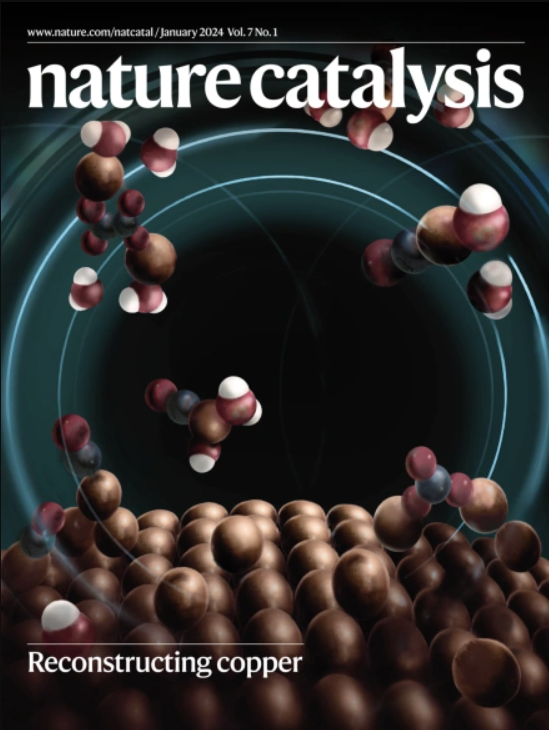含氟镍催化剂对CO2电还原过程中烃链生长及支化程度的控制
IF 44.6
1区 化学
Q1 CHEMISTRY, PHYSICAL
引用次数: 0
摘要
镍基材料可以促进电催化CO2还原(CO2R)反应生成高达C6的碳氢化合物。在这里,我们发现氟掺杂改变了Ni活性位点的性质,这被证明有助于调整CO2R的选择性。我们用中间代物,包括醛、烷基碘化物和乙炔来研究CO2R反应机理。醛被电还原成醇和脱氧中间体。在后者中,与*CO反应的不饱和烃中间体(RCH2 - x*,星号表示表面结合的物质,x = 1或2)决定了链的扩展,由竞争性的C-C偶联和C-H加氢反应调节。烃类化合物的支化始于*CO与两种*CH2的偶联,利用脉冲电位策略可以使支链烃比增加一倍。逆H/D动力学同位素效应促进了氘化烃的形成,法拉第效率为22.2%。这项工作揭示了将二氧化碳转化为线性和支链碳氢化合物的机制和策略,从而推动了电合成燃料的发展。本文章由计算机程序翻译,如有差异,请以英文原文为准。


Controlling hydrocarbon chain growth and degree of branching in CO2 electroreduction on fluorine-doped nickel catalysts
Nickel-based materials can facilitate the electrocatalytic CO2 reduction (CO2R) reaction to generate hydrocarbons up to C6. Here we show that fluorine doping alters the nature of the Ni active sites, which proves instrumental in tuning the selectivity of the CO2R. We interrogate the CO2R reaction mechanism using intermediate surrogates, including aldehydes, alkyl iodides and acetylene. Aldehydes are electroreduced to alcohols and deoxygenated intermediates. Among the latter, unsaturated hydrocarbon intermediates (RCH2−x*, where the asterisk represents surface-bound species and x = 1 or 2) reacting with *CO dictate chain propagation, modulated by competitive C–C coupling and C–H hydrogenation reactions. Compound branching in the hydrocarbons initiates from *CO coupling with two *CH2 species, and the branch-to-linear hydrocarbon ratio can be doubled using a pulsed potential strategy. An inverse H/D kinetic isotope effect promotes deuterated hydrocarbon formation with a Faradaic efficiency of 22.2%. This work reveals mechanisms and strategies for the conversion of CO2 into linear and branched hydrocarbons, thus advancing electrosynthetic fuel development. Ni-based CO2 reduction electrocatalysts have been reported to produce multicarbon products up to C6 but with limited selectivity. Here the reaction mechanism of the process is elucidated. Consequently, pulsed potential electrolysis and electrolyte deuteration are respectively employed to enhance the selectivity of branched hydrocarbons and increase the total hydrocarbon Faradaic efficiency to 22%.
求助全文
通过发布文献求助,成功后即可免费获取论文全文。
去求助
来源期刊

Nature Catalysis
Chemical Engineering-Bioengineering
CiteScore
52.10
自引率
1.10%
发文量
140
期刊介绍:
Nature Catalysis serves as a platform for researchers across chemistry and related fields, focusing on homogeneous catalysis, heterogeneous catalysis, and biocatalysts, encompassing both fundamental and applied studies. With a particular emphasis on advancing sustainable industries and processes, the journal provides comprehensive coverage of catalysis research, appealing to scientists, engineers, and researchers in academia and industry.
Maintaining the high standards of the Nature brand, Nature Catalysis boasts a dedicated team of professional editors, rigorous peer-review processes, and swift publication times, ensuring editorial independence and quality. The journal publishes work spanning heterogeneous catalysis, homogeneous catalysis, and biocatalysis, covering areas such as catalytic synthesis, mechanisms, characterization, computational studies, nanoparticle catalysis, electrocatalysis, photocatalysis, environmental catalysis, asymmetric catalysis, and various forms of organocatalysis.
 求助内容:
求助内容: 应助结果提醒方式:
应助结果提醒方式:


